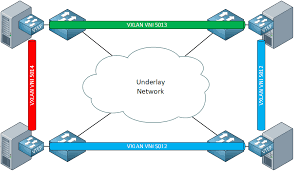Virtual Extensible LAN (VXLAN): Transforming Modern Network Virtualization

Virtual Extensible LAN (VXLAN) is a network virtualization technology designed to address the limitations of traditional VLANs in large-scale cloud and data center environments. As organizations continue to embrace cloud computing, virtualization, and software-defined networking (SDN), the demand for scalable and flexible network architectures has grown significantly. VXLAN plays a crucial role in meeting these demands by providing a framework that extends Layer 2 networks across Layer 3 boundaries, thereby enabling efficient workload mobility, tenant isolation, and simplified management in multi-tenant environments.
VXLAN was developed as an enhancement to VLANs, which traditionally support only 4,094 unique IDs—a limitation that has become insufficient for today’s complex data centers that may host thousands of tenants and virtual networks. VXLAN addresses this scalability challenge by introducing a 24-bit segment identifier, known as the VXLAN Network Identifier (VNI). This innovation allows for the creation of up to 16 million logical networks, far surpassing the capabilities of conventional VLANs. As a result, VXLAN has become the preferred standard for network virtualization in large-scale cloud infrastructures.
One of the defining features of VXLAN is its use of an encapsulation mechanism. VXLAN encapsulates Layer 2 Ethernet frames into UDP packets, which can then traverse an existing IP network. This encapsulation enables the extension of virtual networks across distributed physical infrastructures, allowing data centers in different geographic locations to operate as if they were a single cohesive network. This capability not only enhances workload mobility but also supports hybrid and multi-cloud strategies where enterprises need seamless connectivity between on-premises and cloud-based environments.
Another advantage of VXLAN is its ability to provide network segmentation and tenant isolation in multi-tenant data centers. In environments where multiple customers or departments share the same physical infrastructure, VXLAN ensures that each tenant’s traffic remains secure and isolated. This logical separation is achieved without the need for physical network changes, thus improving operational efficiency while reducing complexity and cost. VXLAN overlays also integrate well with SDN controllers and network automation tools, offering administrators greater visibility and centralized control over large-scale environments.
Performance and scalability are further enhanced by VXLAN’s support for Equal-Cost Multi-Path (ECMP) routing. By leveraging existing IP routing protocols, VXLAN distributes traffic efficiently across multiple network paths, avoiding congestion and ensuring high availability. This is especially important for cloud service providers and enterprises operating mission-critical applications that require low latency and fault tolerance. With hardware and software vendors increasingly offering VXLAN support in switches, routers, and hypervisors, the ecosystem for deployment continues to grow robustly.
Source - https://www.marketresearchfuture.com/reports/virtual-extensible-lan-market-22206
Virtual Extensible LAN has emerged as a cornerstone technology in modern networking, addressing the scalability, mobility, and isolation challenges of traditional VLANs. By extending Layer 2 networks across Layer 3 infrastructure and supporting millions of logical networks, VXLAN empowers organizations to build flexible, efficient, and secure virtualized environments. As digital transformation accelerates and enterprises move toward cloud-first strategies, VXLAN is expected to remain integral in shaping the future of network virtualization and data center design.
- Art
- Causes
- Crafts
- Dance
- Drinks
- Film
- Fitness
- Food
- Games
- Gardening
- Health
- Home
- Literature
- Music
- Networking
- Other
- Party
- Religion
- Shopping
- Sports
- Theater
- Wellness


